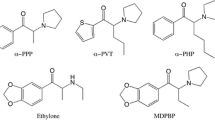Abstract
The discriminative stimulus properties of scopolamine, a potent antagonist at muscarinic receptors, were used for testing the discriminative effects of drugs known to act on cholinergic transmission. Rats were trained in a standard two-bar operant conditioning procedure with food as the reinforcer, according to a FR10 schedule. The training dose of scopolamine was progressively reduced from 0.25 mg/kg SC to the low dose of 0.062 mg/kg SC. Scopolarmine yielded an accurate discrimination in all the six rats tested. The generalization gradient resulted in an ED50 of 0.027 mg/kg. The scopolamine cue lasted for 1 h and was of central origin, since it was not mimicked by scopolamine methylbromide. The scopolamine stimulus generalized to atropine and trihexyphenidyl (respective ED50 values 2.20 and 0.21 mg/kg SC). Atropine depressed rate of responding, while trihexyphenidyl did not. Antagonism experiments with both direct agonists at the muscarinic receptor (arecoline and oxotremorine) and indirect agonists, i.e., inhibitors of the acetylcholine esterase [physostigmine and tetrahydroaminoacridine (THA)], led to inconsistent results. Increasing the doses of the agonists in order to block the scopolamine cue may be limited by their rate suppressant effect on responding. Based upon previously published results, it is suggested that the muscarinic agonist cue is more useful than the antagonist cue for investigating muscarinic transmission.
Similar content being viewed by others
References
Bammer G (1982) Pharmacological investigations of neurotransmitters involvement in passive avoidance responding: a review and some new results. Neurosci Behav Rev 6:247–296
Barry H III (1974) Classification of drugs according to their discriminable effects in rats. Fed Proc 33:1814–1824
Beardsley PM, Balster RL, Salay JM (1987) Separation of the response rate and discriminative stimulus effects of phencyclidine: training dose as a factor in phencyclidine-saline discrimination. J Pharmacol Exp Ther 241:159–165
Colpaert FC (1982) The pharmacological specificity of opiate drug discrimination. In: Colpaert FC, Slangen JL (eds) Drug discrimination: application in CNS pharmacology. Elsevier, North Holland, Amsterdam, pp 3–16
Colpaert FC, Rosecrans JA (1978) Stimulus properties of drugs: 10 years of progress. Elsevier, NOrth Holland, Amsterdam
Colpaert FC, Niegmegeers CJE, Janssen PAJ (1975) The narcotic cue: evidence for the specificity of the stimulus properties of narcotic drugs. Arch Int Pharmacodyn Ther 218:268–276
Finney DJ (1971) Probit analysis. Cambridge University Press, Cambridge
Freedman SB, Beer MS, Harley EA (1986) Apparent affinities of muscarinic antagonists at binding sites in rat heart and brain. TIPS [Suppl] 7:79–80
Jung M, Costa L, Shearman GT, Kelly PH (1987a) Discriminative properties of muscarinic agonists. Psychopharmacology 93:139–145
Jung M, Perio A, Terranova JP, Worms P, Biziere K (1987b) Effects of intracerebroventricular pirenzepine on muscarinic discriminations in rats. Eur J Pharmacol 139:111–116
Kaul PN (1962) Enzyme inhibiting action of tetrahydroamino-acridine and its structural fragments. J Pharm Pharmacol 14:243–248
Kubena RK, Barry H (1969) Generalization by rats of alcohol and atropine stimulus characteristics to other drugs. Psychopharmacologia 15:196–206
Luthin GR, Wolfe BB (1984) Comparison of (3H)pirenzepine and (3H)quinuclidinylbenzilate binding to muscarinic cholinergic receptors in rat brain. J Pharmacol Exp Ther 228:643–655
McKim WA (1976) The effects of pre-exposure to scopolamine on subsequent drug state discrimination. Psychopharmacology 47:153–155
Meltzer LT, Rosecrans JA (1981) Discriminative stimulus properties of arecoline: a new approach for studying central muscarinic receptors. Psychopharmacology 75:383–387
Overton DA (1979) Drug discrimination training with progressively lowered doses. Science 205:720–721
Overton DA (1966) State dependent learning produced by depressant and atropine-like drugs. Psychopharmacologia 10:6–31
Overton DA (1982) Comparison of the degree of discriminability of various drugs using a T-maze drug discrimination paradigm. Psychopharmacology 76:385–395
Overton DA (1983) Test for a neurochemically specific mechanism mediating drug discriminations and for stimulus masking. Psychopharmacology 81:340–344
Overton DA, Leonard WR, Merkle DA (1986) Methods for measuring the strength of discriminable drug effects. Neurosci Biobehav Rev 10:251–263
Pratt JA, Stolerman IP, Garcha HS, Giardini U, Feyerabend C (1983) Discrimination stimulus properties of nicotine: further evidence for mediation at a cholinergic receptor. Psychopharmacology 81:54–60
Schechter MD, Rosecrans JA (1972a) Nicotine as a discriminative cue in rats: Inability of related drugs to produce a nicotine-like cueing effect. Psychopharmacologia 27:379–387
Schechter MD, Rosecrans JA (1972b) Effect of mecamylamine on discrimination between nicotine and arecoline-produced cues. Eur J Pharmacol 17:179–182
Schechter MD, Rosecrans JA (1972c) Atropine antagonism of arecoline-cued behavior in the rat. Life Sci 2:519–523
Siegel S (1956) Nonparametric statistics for the behavioral sciences. McGraw Hill, New York
Snyder SH, Chang KJ, Kuhar MJ, Yamamura HI (1975) Biochemical identification of the mammalian muscarinic cholinergic receptor. Fed Proc 34:1915–1921
Stolerman IP, Garcha HS, Pratt JA, Kumar R (1984) Role of training dose in discrimination of nicotine and related compounds by rats. Psychopharmacology 84:413–419
Stolermann JP, Shine PJ (1985) Trends in drug discrimination research analysed with a cross-indexed bibliography, 1982–1983. Psychopharmacology 86:1–11
Winer BJ (1971) Statistical principles in experimental design, 2nd edn. McGraw Hill, New York
Author information
Authors and Affiliations
Rights and permissions
About this article
Cite this article
Jung, M., Perio, A., Worms, P. et al. Characterization of the scopolamine stimulus in rats. Psychopharmacology 95, 195–199 (1988). https://doi.org/10.1007/BF00174509
Received:
Revised:
Issue Date:
DOI: https://doi.org/10.1007/BF00174509




